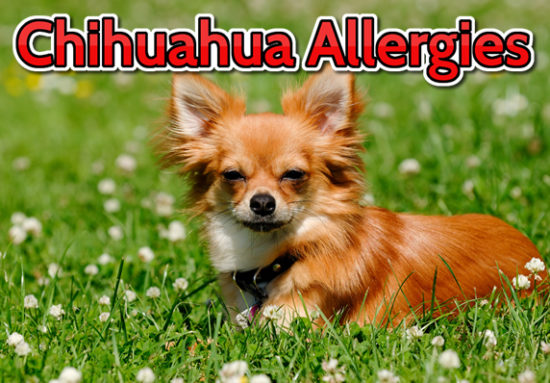
If you’ve noticed your Chihuahua licking, scratching or chewing himself excessively, he could be suffering from an allergies.
Affecting up to 27% of all dogs, allergies are one of the most common chronic diseases in Chihuahuas. Some Chihuahuas develop allergies seasonally, whereas others experience them year-round. Unfortunately, owners often mistake the symptoms of a reaction to other conditions like mange or ringworm, resulting in ineffective treatment.
In this article, we’re going to explore the following topics about Chihuahua allergies:
- What causes allergies in Chihuahuas
- What happens during an allergic reaction
- The different types of allergies
- Symptoms of an allergic reaction
- Testing methods to diagnose allergies
- Medication and treatment for allergies
Overview of Chihuahua Allergies
Allergies are characterized by an overactive immune response to one or more foreign objects. When a foreign object to which a Chihuahua is allergic (allergen) enters his body or makes direct contact with his skin, the Chihuahua’s immune system responds by producing an excessive amount of antibodies; thus, causing an allergic reaction.
Antibodies are normally harmless; in fact, they play an important role in a healthy immune system by neutralizing harmful bacteria and viruses. If a Chihuahua becomes an infected with bacteria or a virus, his immune system will respond by sending antibodies to attack the pathogen.
Some Chihuahuas, however, experience a hypersensitive immune response to otherwise harmless substances like pollen, dust and food ingredients.
With allergies, the Chihuahua’s immune system “thinks” it’s being invaded by a pathogen, so it produces an excessive amount of antibodies to attack the substance. The antibodies attach themselves to the allergen to form a cell mast. When the cell mast collapses, it releases powerful chemicals like histamines and prostaglandins, which causes skin inflammation, redness, itching and other characteristic symptoms of an allergy attack.
Symptoms of Allergies in Chihuahuas
The symptoms of an allergic reaction vary depending on the way in which the Chihuahua’s immune system responds to the allergen. Some Chihuahuas may only sneeze, whereas others may scratch their skin and lick their paws. Additionally, the severity of these symptoms typically increases with age, which is why it’s important to provide proper treatment.
Here are some common symptoms of an allergic reaction:
- Pruritus (severe itching)
- Scratching
- Excessive hair loss
- Skin redness
- Skin inflammation
- Dry, flaking skin
- Sneezing
- Runny eyes
- Rubbing face with paws
- Paw licking
- Whining/whimpering
- Reverse sneezing
- Scooting bottom across floor
- Secondary skin and ear infections
When food allergies are to blame, a Chihuahua may also exhibit gas, diarrhea, constipation, vomiting and slowed growth.
Can Chihuahuas Develop Allergies Later in Life?
Some owners assume their Chihuahua is safe from allergies just because they’ve never experienced an allergic reaction. The truth, however, is that no dog is born with an allergy; it’s a condition they develop over time. Most allergies in Chihuahuas, for instance, manifest between the ages of 6 months and 2 years. Prior to this time, the Chihuahua won’t experience any adverse reactions when exposed to the allergen.
What Causes Allergies?
Both generic and environmental factors play a role in the development of allergies. If a sire or dam has allergies, the pup is also more likely to develop allergies. Therefore, many veterinarians and breed experts caution against breeding Chihuahuas that suffer from allergies.
Exposure to allergens at an early age can also sensitize pups to the respective allergens, increasing the risk of allergies later in life. If a Chihuahua pup is frequently exposed to dust mites, for example, he’s more likely to develop dust mite allergies as an adult.
The Different Types of Allergies in Chihuahuas
There are four primary types of allergies from which Chihuahuas may suffer.

#1) Flea
Flea Allergy Dermatitis (FAD) is the most common type of allergy from which Chihuahuas suffer, accounting for roughly half of all dermatological cases seen by vets. While most Chihuahuas experience some degree of itching from flea bites, those suffering from FAD will experience more severe and intense itching — and it only takes a single bite to trigger this reaction.
When a flea bites a Chihuahua, it draws blood while simultaneously injecting a small amount of saliva into the skin. Flea saliva contains over 15 allergenic chemicals and compounds that may trigger an allergic reaction. If a Chihuahua is allergic to one or more of these compounds, he will scratch and chew himself profusely, especially on the skin right above his tail.
You can typically diagnose FAD by monitoring your Chihuahua’s environment for fleas. If you discover fleas in your home and notice your Chihuahua scratching and chewing himself, he’s probably suffering from FAD, in which case you should take steps to eliminate these pests from your home.
Tips for eliminating fleas in your home:
- Keep relative humidity below 50%
- Set your thermostat to 74 degrees Fahrenheit or below
- Wash your Chihuahua’s beds, blankets and other bedding with hot water
- Bathe your Chihuahua twice weekly
- Brush your Chihuahua’s coat using a flea comb daily
- Vacuum floors daily
- Maintain a clean landscape by mowing grass and brush
- Sprinkle diatomaceous earth (DE) around beds and high-traffic areas
- Treat your Chihuahua with a flea preventative medicine
- Rinse and repeat these steps until the fleas are gone
Keep in mind that only 5% of a typical flea infestation consists of adult fleas. The remaining 95% are pupae, larvae and eggs. So, if you see 50 adult fleas in your home, there are probably 950 other fleas waiting to develop.
#2) Inhalant
Also known as atopic dermatitis or simply atopy, inhalant allergies are the second most common type of allergies in Chihuahuas. They are caused by airborne compounds like tree pollen, weed pollen, grass pollen, mold, fungi and dust mites. Upon inhaling an allergen, the Chihuahua will experience intense itching throughout his body as well as upper-respiratory symptoms like sneezing and runny eyes.
Inhalant allergies can be seasonal, or they can be year-round. If a Chihuahua is only allergic to ragweed pollen, for instance, he may only experience symptoms during summer and spring. If he’s allergic to mold, on the other hand, his symptoms may persist throughout the year unless mold is eliminated and controlled in his environment.
Dust Mites
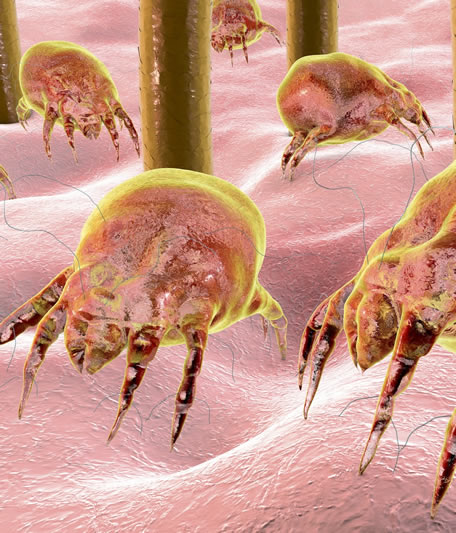
According to DVM360, 30% to 80% of all dogs with allergies are allergic to dust mites (Dermatophagoides farinae). With an average length of just 0.008 to 0.012 inches (0.2–0.3 mm), dust mites are too small to see with the naked eye. If you were to look at them under a microscope, however, you’d see tiny eight-legged bugs that resemble a fat-bodied spider.
Dust mite allergies are triggered by a digestive enzyme found in their feces (Peptidase 1). Dust mites feed on the dead skin cells of humans and animals as well as certain types of mold. And being that we shed roughly 1.5 grams of skin daily, finding food isn’t a problem for these pests. Over the course of 10 weeks, a single dust mite can produce up to 2,000 particles of allergenic feces.
Just how common are dust mites in the home? Statistics show that a used mattress can contain up to 10 million dust mites, while a single square foot carpet can contain up to 1,000 dust mites.
Dust mite allergies aren’t limited strictly to pets. According to the Asthma and Allergy Foundation of America (AAFA), it’s one of the most common triggers of allergies and asthma in people. So, if you suffer from year-round allergies, dust mites could be to blame.
Tips for controlling dust mites and other inhalant allergens in your home:
- Keep relative humidity below 50%
- Turn on bathroom exhaust fan when showing or bathing
- Keep windows and doors shut
- Install a High Efficiency Particulate Arresting (HEPA) air filter, replacing it every 60 to 90 days*
- Install an air purifier
- Vacuum floors with a HEPA vacuum cleaner*
- Leave your shoes at the front door
- Store your Chihuahua’s food in a sealed container
- When mowing your lawn, bag and dispose of grass clippings away from house
- Wash pet bedding as well as your own bedding weekly
- Wash curtains and drapes
- Clean windows and windowsills
- Dust furniture and hard surfaces with a damp washcloth
*HEPA filters are designed to filter at least 99.97% of all airborne particles that are 0.3 microns or larger. To put that number into perspective, 0.3 microns is roughly 0.000011811 inches.
#3) Food
Accounting for roughly 10% of all canine allergies, food allergies are the third most common allergy in Chihuahuas. Also known as food hypersensitivity, it’s characterized by an overactive immune response to one or more ingredients found in food. Like other allergies, the Chihuahua’s immune system wrongfully identifies the ingredient as being a foreign invader, resulting in the various biochemical reactions and subsequent allergy symptoms.
The most common food allergens, in order of occurrence, include:
- Beef (accounts for roughly one-third of all food-related allergies in dogs)
- Dairy
- Chicken
- Wheat
- Egg
- Lamb
- Soy
- Corn
- Pork
- Rice
- Fish
- Rabbit
- Yeast
Beware of Food Additives!

While most food-related allergies are triggered by the ingredients listed above, some are caused by additives such as butylated hydroxyanisole (BHA), butylated hydroxytoluene (BHT), tertiary butylhydroquinone (TBHQ), ethoxyquin, propylene glycol, propyl gallate, monosodium glutamate (MSG / E621), artificial dyes and trans fat.
Treating Chihuahua Food Allergies with a Novel Diet
Medications like antihistamines and corticosteroids may offer some relief of food allergies, but it only masks the symptoms rather than treating the underlying cause. As long as your Chihuahua consumes the ingredient to which he is allergic, he will continue to exhibit allergy symptoms. Therefore, you need to identify the problematic ingredient by introducing your Chihuahua to a novel diet.
A novel diet consists of proteins and carbohydrates that your Chihuahua hasn’t previously consumed in his diet. If your Chihuahua usually eats a beef and rice food, for instance, try transitioning him to rabbit and sweet potato food. If symptoms don’t improve after two to three months, try a different food consisting of a new protein and carbohydrate. During this trial period, avoid feeding your Chihuahua treats, chews, rawhides or table food.
The goal of a novel diet is to find the right combination of proteins and carbohydrates that doesn’t trigger an allergic reaction. Once you’ve found a combination that works, you can gradually add other ingredients to your Chihuahua’s diet until his nutritional needs are met. With that said, you should never starve your Chihuahua when introducing him to a novel diet. If he’s not eating a new food, contact your veterinarian for advice.
Food Allergy vs Food Intolerance
Not all adverse reactions to food are caused by allergies. Chihuahuas can have a food intolerance, which is characterized by an adverse reaction by the digestive system instead of the immune system. Because it’s not associated with an immune response, traditional allergy medication is ineffective at treating a food intolerance.
Symptoms of a food intolerance are often similar to a food allergy, with affected Chihuahuas experiencing diarrhea, nausea, vomiting and bloating. Because of these similarities, many owners mistakenly believe their Chihuahua suffers from a food allergy when they really have an intolerance. However, one noticeable difference is that food allergies typically cause itching as well, whereas food intolerance only causes gastrointestinal symptoms.
A food intolerance can progress to a food allergy if left unaddressed. If you believe your Chihuahua suffers from a food allergy or an intolerance, you should introduce him to a novel diet to identify the problematic ingredient or ingredients. Once you’ve found the ingredient that triggers your Chihuahua’s adverse reaction, you can eliminate it from his diet.
#4) Contact
Contact allergies are the least common type of allergies in Chihuahuas. As the name suggests, they are triggered by direct skin contact with the respective allergen, resulting in localized symptoms at the point of contact.
Contact allergens may include antibiotic creams, nickel, chromium, leather, rubber, wool and plastic.
Allergic Contact Dermatitis vs Irritant Contact Dermatitis
There’s also irritant contact dermatitis, which is caused by direct contact with irritating plants, chemicals or substances. Irritant contact dermatitis, however, isn’t associated with an allergic reaction, nor does it require a period of sensitization. Rather, all Chihuahuas will experience a negative skin reaction when exposed to the irritating substance. Exposure to bleach-based cleaning products, road salt and solvent chemicals are common triggers of irritant contact dermatitis.
Allergy Testing and Diagnosis
The single most effective solution for preventing allergy attacks is to remove the allergen from the Chihuahua’s environment. If your Chihuahua is allergic to nickel, for instance, you should avoid using leashes, collars, dog bowls or other pet products containing this metal. Or if he’s allergic to ragweed pollen, monitor the pollen count in your area and keep your Chihuahua indoors — with the occasional outdoor bathroom break — when ragweed levels are high.
To do this, however, you must first identify the specific allergen that triggers his attacks. Only then can you eliminate the allergen from his environment. Implementing a hypoallergenic novel dietary trial can help owners identify and avoid food-related allergens (see above). For inhalant and contact allergies, the following testing methods are available.
Serum Testing
Serum testing involves taking a sample of the Chihuahua’s blood and testing it for allergen-specific immune globulin E (IgE) antibodies. The suspected allergen is added to the blood sample, and if the Chihuahua is allergic to that allergen, IgE antibodies will bind to it.
There are two primary serum tests available: RAST (radioallergosorbent) and the newer ELISA (enzyme-linked immunosorbent assay). Both tests use a similar process, though the latter is said to be more accurate. Serum testing takes several weeks to complete, with an average cost of $200 to $300.
Intradermal Skin Testing (Recommended)
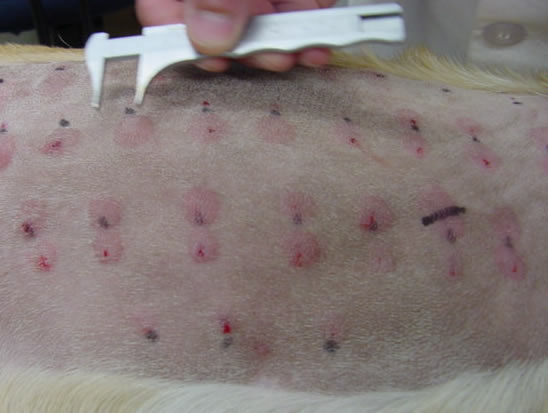
Also known as prick testing, intradermal skin testing is the recommended method for diagnosing allergies in Chihuahuas. Studies show it’s 75% accurate at identifying allergens in dogs, making it far more effective than RAST and ELISA testing. The Chihuahua is sedated and partially shaved to expose his skin, after which the veterinarian carefully injects up to 70 different possible allergens into his skin. If the Chihuahua is allergic to one of these allergens, a localized reaction will occur.
Not all Chihuahuas are suitable candidates for intradermal skin testing, however. If your Chihuahua’s skin is severely damaged — from scratching, infection or inflammation — the veterinarian may recommend serum testing instead. Intradermal skin testing also requires the Chihuahua to stop taking antihistamines, corticosteroids and other allergy drugs for at least several weeks prior to the test.
Additionally, owners of Chihuahuas that compete in the show ring are often reluctant to use intradermal skin testing, as it requires a substantial area of the Chihuahua’s body to be shaved.
Intradermal skin testing is typically performed within just a few hours, with an average cost of $250 to $300.
Hair and Saliva Testing
There are also hair and saliva tests available to diagnose allergies in Chihuahuas. You collect the hair and/or saliva sample from your Chihuahua and then ship it to the company’s lab for testing. Unfortunately, it’s the least accurate testing method and often results in false positives. Because of this, neither the American College of Veterinary Dermatology (ACVD) nor the European College of Veterinary Dermatology (ECVD) recommends hair and saliva testing to diagnose allergies in dogs.
Hair and saliva tests take a few weeks to complete, with an average cost of $75 to $150.
How to Treat Allergies in Chihuahuas
While there’s no vaccine available to prevent allergies in Chihuahuas, there are treatment options available to reduce the severity and frequency of attacks, including omega-3 fatty acids, antihistamines, corticosteroids, immune modulators, immunotherapy, biotin, yucca root, probiotics, essential oils and medicated shampoos.
Omega-3 Fatty Acids
Omega-3 fatty acids work by reducing inflammation in the body, which is a characteristic symptom of an allergic reaction. There are several different types of omega-3s, including ALA (alpha linoleic acid), EPA (eicosapentaenoic acid), and DHA (docosahexaenoic acid). While all omega-3s may offer some relief of allergies in Chihuahuas, EPAs are the most effective for allergies. EPAs are commonly found in fish and fish oil, whereas DHAs and ALAs are found in vegetables and grains.
In addition to feeding your Chihuahua food containing fish, you can also increase his intake of omega-3s with supplements, such as those offered by Nordic Naturals and Nutramax. Most veterinary experts recommend a dosage of 20 to 50 mg omega-3s per pound of body weight.
Don’t confuse omega-3 with omega-6 fatty acids, because only the former reduces inflammation. Omega-6 fatty acids have the opposite effect by promoting inflammation and potentially worsening the Chihuahua’s allergies. Nonetheless, Chihuahuas need both omega-6s and omega-3s at about a 10:1 ratio for proper immune function.
Omega-3s work best when used in conjunction with other allergy medications, such as antihistamines or corticosteroids.
Antihistamines

Antihistamines such as diphenhydramine (Benedryl), chlorpheniramine (Chlortimeton), hydroxyzine (Atarax) and cetirizine (Zyrtec) may offer relief of allergies in Chihuahuas by blocking the release of histamines. Once administered, the drug binds to the Chihuahua’s histamine receptors, weakening the histamine reaction associated with allergies.
The most common side effect of antihistamines in Chihuahuas is drowsiness.
Dosage for the antihistamine diphenhydramine is 1 mg per pound of your Chihuahua’s body weight, administered two to three times per day. If your Chihuahua is reluctant to consume liquid diphenhydramine, try the tablet form. You can make tablets more palatable by covering them in a small amount of peanut butter or regular butter. Just remember to choose diphenhydramine that doesn’t contain other drugs like pseudoephedrine or acetaminophen (Tylenol).
However, antihistamines are only effective in about 30% of Chihuahuas, and they typically only work when taken before an allergic reaction occurs. But just because one antihistamine is ineffective doesn’t necessarily mean they all are. If your Chihuahua has taken an antihistamine daily for at least a week without experiencing any relief of his allergies, switch to a different antihistamine. Through trial and error, you can often find one that works for your Chihuahua’s allergies.
Corticosteroids
Corticosteroids are powerful drugs that suppress the immune system’s response to allergens, similar to the way in which antihistamines work. Antihistamines, however, only block the release of histamines, whereas corticosteroids target multiple chemicals associated with allergies, including histamines, prostaglandins and other chemicals. Because of this multi-pronged approach, corticosteroids are one of the most effective types of canine allergy medication on the market.
While effective at treating allergies, corticosteroids carry a risk of many short- and long-term side effects, including aggression, increased thirst, increased hunger, increased urination, vomiting, diarrhea, liver dysfunction and infection. Side effects can be minimized by tapering your Chihuahua down to a lower dosage, as per your veterinarian’s instructions.
Corticosteroids are available in oral, injectable and topical forms. Injectable corticosteroids are the most effective but also have the greatest risk of adverse side effects, whereas topical corticosteroids are the least effective and have the lowest risk of adverse side effects. Oral corticosteroids fall somewhere in the middle, offering a harmonious balance between strength and safety.
The same drugs are often found in both oral and injectable corticosteroids, including betamethasone, dexamethasone, flumethasone, methylprednisolone, prednisolone and triamcinolone. Topical corticosteroids include clobetasol propionate, hydrocortisone, mometasone and triamcinolone.
Immune Modulators

Immune modulators are drugs used to treat and manage allergies by regulating the immune system. They are fast acting, effective, have mild side effects — nausea, vomiting and diarrhea — and don’t cause dependency. Symptoms are improved in about half of all Chihuahuas treated with immune modulators.
Although rare, immune modulators may cause liver problems and anemia. Routine blood analysis is required for long-term use of immune modulators to monitor the Chihuahua’s white blood cell count and liver enzymes.
The U.S. Food and Drug Administration (FDA) has approved the immune-modulating drugs Apoquel (oclacitinib) and Atopica (cyclosporine) for use in the treatment of canine atopic dermatitis, both of which work by inhibiting the production and release inflammatory cytokines. Apoquel and Atopica offer relief from all types of allergies.
Apoquel should only be given to Chihuahuas over 12 months of age and weighing at least 6.6 pounds. Atopica should only be given to Chihuahuas over 6 months of age and weighing at least 4 pounds. Both drugs require a prescription from your veterinarian.
Immunotherapy
A relatively new treatment for canine allergies is immunotherapy. Also known as hyposensitization, it involves injecting small amounts of the substances to which your Chihuahua is allergic under his skin, with the goal of desensitizing your Chihuahua to the respective allergens. As the Chihuahua is exposed to the allergens, his immune system begins to correct itself by developing a tolerance to them; thus, reducing the risk of future allergy attacks being triggered by the allergens.
According to Banfield, reports show that immunotherapy has a 50% to 80% success rate when used to treat allergies in dogs. However, it can take up to five months before any noticeable change in symptoms occurs.
Before immunotherapy can be performed, an allergy test is needed to identify the exact compounds to which your Chihuahua is allergic. Once these compounds have been identified, a series of injectable shots containing the antigens will be prepared. Most dogs begin at a lose dosage, with the veterinarian gradually increasing the dog’s dosage every six weeks until a maintenance dose is achieved.
When performed under the guidance of a veterinarian, adverse side effects of immunotherapy are minimal, consisting only of localized allergic reactions at the site of injection. Immunotherapy can be performed at your veterinarian’s office, or you can inject the shots into your Chihuahua at home.
However, the first few injections should be performed at the veterinarian’s office so he or she can monitor your Chihuahua for signs of a rare but serious side effect known as anaphylaxis. Assuming your Chihuahua experienced either no adverse reaction or a mild adverse reaction, your veterinarian may allow you to perform the injections at home, which significantly reduces the cost of immunotherapy.
Because their immune systems are still developing, immunotherapy is most effective when performed on younger Chihuahuas with allergies. A senior Chihuahua may experience little-to-no relief from immunotherapy.
Biotin
Vitamin B7, or what’s more commonly known as biotin, may relieve some of the symptoms associated with allergies in Chihuahuas. This water-soluble vitamin performs a variety of functions, including fat synthesis, regulating metabolism, cardiovascular health, digestion, nervous system function, skin health, coat health and more.
According to a 1989 Swiss study of 119 dogs suffering from dermatitis, itching and other skin problems, biotin was effective in 91% of dogs. For 60% of the dogs, it completely eliminated their symptoms.
Because biotin is water-soluble, it doesn’t have any adverse side effects. If your Chihuahua consumes too much, he willy simply pass the excess through his urine. However, it can take up to three months for any noticeable change in your Chihuahua’s symptoms to occur.
Biotin is found in eggs, legumes, whole grains and fish. Alternatively, you can give your Chihuahua a biotin supplement. Biotin supplements should be given on an empty for maximum absorption.
Yucca Root

Typically sold as supplements or powder, yucca root consists of finely ground roots of the yucca plant (family Asparagaceae, subfamily Agavoideae). It contains a plethora or beneficial nutrients such as vitamin C, calcium, iron, magnesium, manganese, niacin, beta-carotene, phosphorus and vitamin B.
While used to treat many ailments, yucca root is particularly effect at treating allergies thanks to its naturally occurring glycosides known as saponins. These saponins work by relieving inflammation, which of course is a characteristic symptom of allergies. Yucca root is also used to treat arthritis, digestion problems and hip dysplasia.
Yucca root is perfectly safe for Chihuahuas, though the plant from which it comes is not. The yucca plant (see photo to the right) is mildly toxic to dogs and may cause nausea and diarrhea. Therefore, only the root should be given to Chihuahuas as a supplement.
Probiotics
Not all bacteria to which Chihuahuas are exposed are harmful. Some, in fact, are actually beneficial to their health.
Chihuahuas have millions of good bacteria living in their gut, which are responsible for breaking down food, fighting harmful pathogens, creating vitamins and supporting a healthy immune system. When these bacteria colonies are eliminated or otherwise disrupted, it can lead to digestive distress, malnutrition, infection and even allergies. Probiotics, however, are used to restore the balance of good bacteria in the gut and protect against conditions such as these.
The term “probiotics” refers to any bacteria or yeast that promotes good health when ingested. Natural sources of probiotics include yogurt, kefir, sauerkraut and other fermented foods. Because most of these foods contain other ingredients that aren’t well tolerated by dogs, it’s recommended that you give your Chihuahua a supplement instead. Available in both capsule and liquid form, the latter of which requires refrigeration, probiotic supplements contain the same beneficial bacteria found in the gut.
Probiotic supplements for dogs typically contain the same beneficial bacteria found in the digestive tract, some of which include:
- Lactobacillus acidophilus
- Lactobacillus plantarum
- Lactobacillus brevis
- Lactococcus lactis
- Enterococcus faecium
- Bifidobacterium lactis
- Lactobacillus casei
- Bifidobacterium breve
When choosing probiotics for your Chihuahua, check the label to determine what strains it has and how many living bacteria are in it. Some probiotic manufacturers guarantee a minimum amount of live bacteria when consumed before a specified date.
Essential Oils
Essential oils are used to treat itching, inflammation, pain and other symptoms of an allergy attack. Some even contain anti-fungal and antiseptic properties, making them particularly effective at treating and preventing skin infections caused by allergies.
Essential oils can be applied directly to your Chihuahua’s skin or emitted as a breathable vapor into the air via a diffuser.
Some of the most commonly used essential oils include:
- Lavender: anti-inflammatory, antiseptic, anti-fungal and antibacterial properties
- Peppermint: anti-inflammatory, antiseptic and pain-relieving properties
- Myrrh: anti-inflammatory, antiseptic, and astringent properties
- Lemongrass: heals damaged skin and protects against fleas, ticks and other insects
- Helichrysum: Antiseptic and pain-relieving properties while also healing damaged skin
- Niaouli: an alternative to tee tree oil, niaouli oil has antihistamine, antibacterial and anti-inflammation properties
You should only choose therapeutic-grade oils, as aromatherapy-grade oils may contain irritating and potentially harmful added chemicals.
Additionally, you should dilute the essential oil with a base oil like olive oil. Unless it’s formulated for dogs, most store-bought essential oils are too strong for our canine companions. Therefore, it’s recommended that you dilute it to 20 parts base oil to every one part essential oil. For every one drop of essential oil, for instance, you should add 20 drops of base oil.
Medicated Shampoo
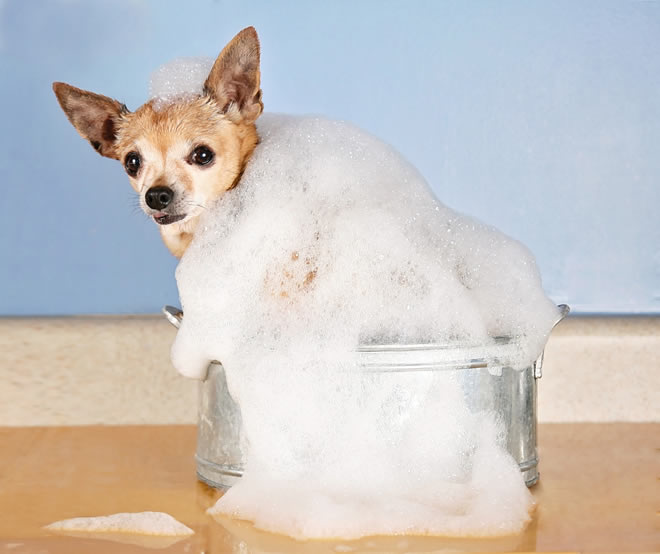
Finally, medicated shampoo can relieve your Chihuahua’s allergies by moisturizing his skin, neutralizing itching, and removing topical allergens, oil, bacteria and yeast. A hypoallergenic shampoo containing miconazole and chloroxylenol, for instance, inhibits microbial growth to protect against secondary skin infections, whereas shampoos containing emollients like aloe vera and coconut oil moisturize and protect against dryness.
Some shampoos have an anti-pruritic effect, neutralizing the itching caused by allergies. If your Chihuahua suffers from intense itching, try a hypoallergenic medicated shampoo containing colloidal oatmeal. Colloidal oatmeal has been used to treat skin ailments for thousands of years, with some of its first recorded uses dating back to Ancient Egypt. It consists of finely ground oatmeal (Avena sativa) that’s suspended in a liquid for maximum absorption. In addition to supplementing your Chihuahua with beneficial nutrients like protein and vitamin E, colloidal oatmeal soothes and protects against itchy skin.
When bathing your Chihuahua with a medicated shampoo, use lukewarm water instead of hot water. Hot water promotes microbial reproduction and inflammation, which can worsen your Chihuahua’s symptoms.
Secondary Infections
Unfortunately, allergic Chihuahuas are susceptible to secondary skin and ear infections for two reasons:
- Allergies cause Chihuahuas to scratch themselves profusely, resulting in open, infection-prone wounds.
- Allergies are often treated with corticosteroids or other drugs that suppress the immune system, weakening the Chihuahua’s ability to fight off infection.
Secondary infections can be caused by pathogenic bacteria or yeast (fungi). When a bacterial infection occurs, you may notice localized redness, inflammation and pus-filled lesions. Symptoms of a yeast infection are similar but are also accompanied with a distinct foul odor and greasy fur.
Treatment for Secondary Infections
Don’t ignore a secondary infection, as they often require prescription medication to treat. If you believe your Chihuahua is suffering from a secondary infection of the skin or ears, take him to your veterinarian for a proper diagnosis.
After taking a culture sample (if needed), your veterinarian can determine what type of pathogen is causing the infection. Antibiotics are typically used to treat bacterial infections, while anti-fungal drugs are used to treat yeast infections. Medicated shampoos may also be prescribed to treat a secondary infection.
However, antibiotics can also make your Chihuahua more susceptible to yeast infection. Chihuahuas have colonies of good bacteria in their digestive skin and on their skin that help to protect against pathogenic yeast. Antibiotics eliminate all types of bacteria, both good and bad. So, even if antibiotics clear up a bacterial infection, it creates the ideal breeding grounds for a yeast infection.
Elizabethan Collar
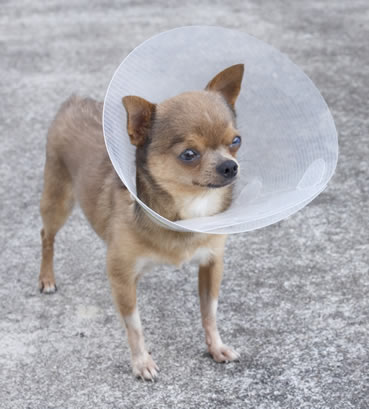
If your Chihuahua has a secondary ear infection, you may want to use an Elizabethan collar. Also known as the cone of shame, this cone-shaped device wraps around your Chihuahua’s neck to prevent him from scratching his ear or face, which could otherwise worsen his infection. An Elizabethan collar can also stop your Chihuahua from biting and chewing a secondary skin infection on his body.
An Elizabethan collar isn’t going to stop your Chihuahua’s ear from itching; it only prevents him from scratching it. Most importantly, you need to treat your Chihuahua’s allergies to stop the itching. Even if a secondary infection clears up, it may return unless your Chihuahua’s allergies are properly managed.
The Bottom Line on Chihuahua Allergies…
As an owner, it’s heartbreaking to see your Chihuahua suffering from allergies. It may begin with him occasionally gnawing his tail, only to progress to constant self-inflicting wounds. Aside from the pain and discomfort this creates, this can also lead to secondary infections. A bald patch of fur can quickly turn into an open, bleeding wound; thus, increasing the risk of a bacterial or yeast infection.
Whether your Chihuahua is suffering from flea, inhalant, food or contact allergies, there are ways to treat and manage his condition. However, you should discuss all possible treatment options with your veterinarian to determine which method is best suited for your Chihuahua. If your Chihuahua suffers from mild seasonal allergies, antihistamines and allergen control may be recommended. If he suffers from severe food allergies, a novel dietary trial may be recommended to identify the problematic ingredient. A licensed veterinarian can help you identify the underlying cause of your Chihuahua’s allergies and offer recommendations on how to treat it.
Does your Chihuahua suffer from allergies? We’d love to hear your story in the comments section below!
References:
https://www.akc.org/content/health/articles/food-allergies-dog-scratching-licking/
https://www.merckvetmanual.com/dog-owners/skin-disorders-of-dogs/allergies-in-dogs
https://vcahospitals.com/know-your-pet/allergy-general-in-dogs
I started giving my dog medicated oatmeal shampoo baths and a daily probiotic supplement called nutra thrive. You put one little scoop in the morning meal and that has helped a lot, but she still gets flare ups. I’m going to try some other things but feel like I need to share the nutra thrive because it has helped.
My 9 year old Chi started with allergies this past year. Coconut Shampoo helps as well as soaking the feet in it for 5 mins. Coconut oil in a spoon or placed on her feet can be safely be licked off by her. She weighs 10 lbs and can take a half of a regular Benedryl if she can’t stop scratching. once in a while she has to wear a blow up neck pillow around her neck. She was on a diet of Salmon and Sweet Potato her Vet \for 5 weeks but I stopped it because of the smell and her breath also had fish smell. I will give her Haddock or white fish once in a while but I find salmon too strong smelling and tasting. She does like Venison and Turkey but hates gravies!
Thank you for all of your advice. Have 5 Chi’s. All fixed and my little appendages. Want them as long as possible! They’re my babies. Have had a time with ear mites for first time. Been using Wesson oil. Is there a better natural treatment. I can’t let them outside as the mites some how finds them. How do ll kill mites outside safely? I do feed squirrels and wild birds. Recently killed rats. Live near a creek street behind my property.
I’ve just rescued a Chihuahua and she’s supposed to be 3yrs old wieghs 2lbs blonde shorthaired and she’s scratches slot rubs face with paws skin redness and gnaws herself
She has an allergy. Could be her diet. I feed my Chi’s small bites salmon, veggies, fruit and Chicken diets. I do feed them real chicken and yams for a treat.
I have a three year old chi-weenie; however he has long legs; a rib-cage more pronounced like a dachshund; and every thing else screams chihuahua; including really thin legs his facial structure is total chihuahua; his abdominal area is much smaller. and he is long like a doxie. And he developed allergies at about 14 months old; lots of backward sneezing; normal sneezing; runny nose; watery eyes;food allergies and intolerance’s; he vomits related to his diet. the vet is confused by him; he really is an anomaly. I have been researching chihuahua for all of his symptoms.I plan on using your advice for chihuahuas due to your info covers all of his issues to the T. I have not found any info so clearly and as comprehensive; He has been on prescription dog food only works for a while then we start all over and try another food. Thank you for this article.
My dog is having breathing problems and has been rubbing her face with her paw an she has been scratching her body a lot but she always had breathing problems but not this bad.
Sounds like food allergies, fleas or maybe mites. Am having a time with ear mites for the first time. Have used it meds and now using Wesson Oil. Read it was safe and does work but everytime they go outside ears are red again. I don’t have a lawn. Gravel up front rest of yard landscaped.
Zyrtec and low dose daily prednisone is the answer to all the above questions.
How many mg per pound of the Zyrtec are you doing Liza?
Here’s the recommended Zyrtec dosage for dogs based on their weight: Less than 10 pounds: 2.5 milligrams (half of a 5-milligram pill or a quarter of a 10-milligram pill) 10–50 pounds: One 10-milligram tablet. 50+ pounds: Up to two 10-milligram tablets.
I have a longhair chihuahua and she is experiencing skin allergies where red spots appear and scabs start forming and it is non-stop. I’ve spent $800 trying to find out what she is allergic to and they could not pinpoint anything. I’ve changed the type of detergent I use for the bedding, her food, her treats. I’ve bathed her only about once a month but recently once a week with the oatmeal shampoo the vet perscribed plus a spray for allergies on the topical skin. It seems to keep spreading and need your help. She has gotten a bit better after all of the above has been done but she has some scabs that keep spreading.
My chihuahua seems to be having allergic reactions to chicken. I’m wondering what is best to feed him? I heard lamb or a turkey but now I’m nervous to change his diet again. Any suggestions?
I have a dog and she is a chihuahua and she been wheezing and honking nose is there a medicine that can help cure it for her allergies. And can most chihuahuas be allergic to Russian olive trees
I have a chihuahua who is Twelve years old and has really bad allergies!!! What can I give her OTC that is liquid?